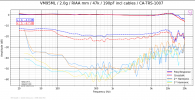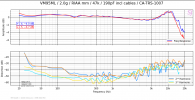Shure V15 V-MR
Click to increase size
View attachment 296644View attachment 296645
Notes
- As good as it gets!
- Essentially flat at ± 0.5 dB
- Lightly used, micro-ridge stylus with beryllium cantilever and dynamic stabilizer brush
- Denon DP-35F has a servo tonearm
- Compare results at 20Hz with ones below to possibly see effect on resonance
- Recorded with Wayne Kirkwood Flat MM Phono Preamplifier (no RIAA for precision) and E1DA Cosmos ADC
- You need to record in 192k for full 3rd harmonic distortion data
- Crosstalk is limited with CA-TRS-1007 but center point at 1kHz should be the measurement (-30 dB)
- I also have copies that show a slight downward slope after 10kHz and I will run a comparison later
Confirmation of results
View attachment 296417View attachment 296418
Notes
- Here I used a Parks Audio Puffin on flat mode with digital out in order to compare and confirm results
- 44.1 recording limits 2nd and 3rd harmonic distortion data
- Here turntable is Denon DP-30L II (with low mass tonearm)
- Non-quartz direct drive with much beefier motor and different tonearm
- So much for turntables having completely different sound signatures!
- Obviously wow & flutter, rumble, tonearm compatibility, loading, and set-up also matter
CBS STR-100
View attachment 296356View attachment 296357
Notes
- Biggest difference is a wide 0.5 dB bell dip in the frequency response
- Account for set-up and general test record margin of error
- CBS STR-100 test records generally vary a little above 10kHz (flattening helps some)
- Crosstalk is limited here to -25dB at 1kHz
- 2nd harmonic distortion is also more limited here at 1kHz to about -40 dB
- Still, this is the best test record still available and at a reasonable price!
I have this:
Features
- Beryllium MICROWALL/Be™ stylus shank provides unrivaled trackability for accurate sound reproduction
- MASAR™ -polished hyperelliptical stylus tip reduces record wear and distortion
- Exclusive SIDE-GUARD stylus protection system guards against accidental stylus damage
- P-mount construction for instant mounting with no further adjustments usually necessary
- The highest ever track ability at 1.25 grams for extended record and tip life
- Undeviating flat response, tightest tolerances ever achieved
Shure V15 Type V-P Phono Cartridge Specifications
- Output voltage @ 1kHz, 5cm/sec: 3.2mV
- Channel balance: 1.5dB
- Channel separation @ 1kHz/10kHz: 25/18dB
- Frequency response: 20Hz-20kHz
- Stylus type: .0002 x .0015 inch nude hyperelliptical
- Tracking force: 1.25 g
- Recommended load resistance: 47k ohms
- Color: Black/Light Gray
- Weight: 5.9 g
- Stylus replacement: Shure VN5P
Should I put the
Jico SAS/Boron stylus on it?



